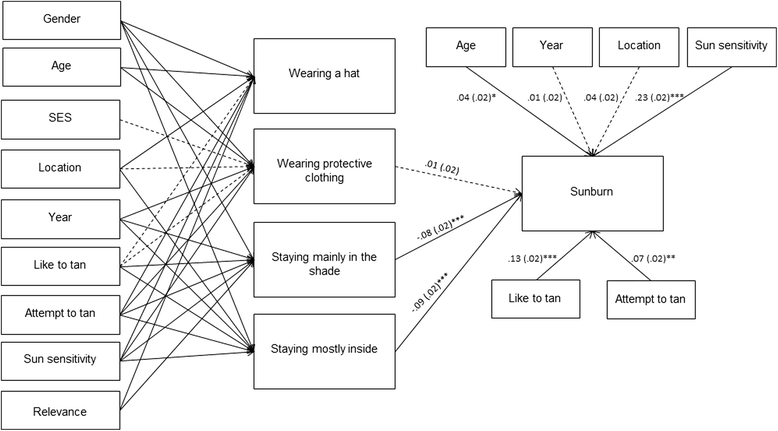Predictors of sun protection behaviours and sunburn among Australian adolescents
- PMID: 27411518
- PMCID: PMC4944266
- DOI: 10.1186/s12889-016-3197-4
Predictors of sun protection behaviours and sunburn among Australian adolescents
Abstract
Background: Excessive sun exposure and sunburn increase individuals' risk of skin cancer. It is especially important to prevent sunburn in childhood due to the higher relative risk of skin cancer across the life span compared to risk associated with sunburn episodes experienced later in life. This study examined demographic and attitudinal factors associated with engagement in a range of sun protection behaviours (wearing a hat, wearing protective clothing, staying in the shade, and staying indoors during the middle of the day) and the frequency of sunburn among Western Australian adolescents to provide insights of relevance for future sun protection campaigns.
Methods: Cross-sectional telephone surveys were conducted annually with Western Australians between 2005/06 and 2014/15. The results from 4150 adolescents aged 14-17 years were used to conduct a path analysis of factors predicting various sun protection behaviours and sunburn.
Results: Significant primary predictors of the sun protection behaviours included in the study were skin type (sun sensitivity), gender, tanning-related attitudes and behaviours, and perceived relevance of public service advertisements that advocate sun protection. Of the four sun protection behaviours investigated, staying in the shade and staying indoors during the middle of the day were associated with a lower frequency of sunburn.
Conclusion: There is a particular need to target sun protection messages at adolescent males who are less likely to engage in the most effective sun protection behaviours and demonstrate an increased propensity to experience sunburn. The results suggest that such future sun protection messages should include a focus on the importance of staying in the shade or indoors during periods of high UV radiation to increase awareness of the efficacy of these methods of avoiding skin cancer.
Keywords: Adolescents; Sun protection; Sunburn; Tanning.
Figures
Similar articles
-
Trends in Australian adolescents' sun-protection behaviours: implications for health campaigns.Aust N Z J Public Health. 2016 Oct;40(5):468-473. doi: 10.1111/1753-6405.12561. Epub 2016 Aug 14. Aust N Z J Public Health. 2016. PMID: 27523880
-
Seven-year trends in sun protection and sunburn among Australian adolescents and adults.Aust N Z J Public Health. 2013 Feb;37(1):63-9. doi: 10.1111/1753-6405.12012. Aust N Z J Public Health. 2013. PMID: 23379808
-
Prevalence of sun-protective behaviour and intentional sun tanning in German adolescents and adults: results of a nationwide telephone survey.J Eur Acad Dermatol Venereol. 2018 Feb;32(2):225-235. doi: 10.1111/jdv.14376. Epub 2017 Jul 3. J Eur Acad Dermatol Venereol. 2018. PMID: 28573745
-
Prevalence of sunburn, sun protection, and indoor tanning behaviors among Americans: review from national surveys and case studies of 3 states.J Am Acad Dermatol. 2011 Nov;65(5 Suppl 1):S114-23. doi: 10.1016/j.jaad.2011.05.033. J Am Acad Dermatol. 2011. PMID: 22018060 Review.
-
Primary prevention of skin cancer: a review of sun protection in Australia and internationally.Health Promot Int. 2004 Sep;19(3):369-78. doi: 10.1093/heapro/dah310. Health Promot Int. 2004. PMID: 15306621 Review.
Cited by
-
Protocol for a cluster-randomized trial of a school-based skin cancer preventive intervention for adolescents.Contemp Clin Trials. 2024 May;140:107494. doi: 10.1016/j.cct.2024.107494. Epub 2024 Mar 6. Contemp Clin Trials. 2024. PMID: 38458557 Free PMC article.
-
Investigating primary preservice teachers' ultraviolet radiation awareness and perceived ability to teach sun safety.Health Promot J Austr. 2021 Oct;32 Suppl 2(Suppl 2):178-184. doi: 10.1002/hpja.401. Epub 2020 Aug 27. Health Promot J Austr. 2021. PMID: 32770684 Free PMC article.
-
Behaviour and sun exposure in holidaymakers alters skin microbiota composition and diversity.Front Aging. 2023 Aug 8;4:1217635. doi: 10.3389/fragi.2023.1217635. eCollection 2023. Front Aging. 2023. PMID: 37614517 Free PMC article.
-
Unintended Sunburn: A Potential Target for Sun Protection Messages.J Skin Cancer. 2017;2017:6902942. doi: 10.1155/2017/6902942. Epub 2017 Apr 3. J Skin Cancer. 2017. PMID: 28473925 Free PMC article.
-
A novel skin cancer prevention strategy: Preservice teachers' perceptions of a sun safety intervention and experiences in schools.Health Promot J Austr. 2023 Feb;34(1):255-263. doi: 10.1002/hpja.638. Epub 2022 Jul 21. Health Promot J Austr. 2023. PMID: 35833309 Free PMC article.
References
-
- Cancer Australia & Australian Institute of Health and Welfare: Non-melanoma skin cancer: general practice consultations, hospitalisation and mortality. Cancer Series no 43. Cat. no. 39. Canberra: AIHW; 2008. Available from: http://www.aihw.gov.au/WorkArea/DownloadAsset.aspx?id=6442454591.
MeSH terms
Substances
LinkOut - more resources
Full Text Sources
Other Literature Sources
Medical


